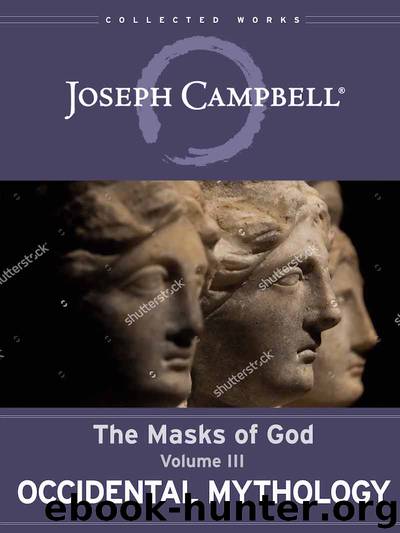Occidental Mythology by Joseph Campbell

Author:Joseph Campbell
Language: eng
Format: epub
ISBN: 978-1-61178-003-1
Publisher: PublishDrive
Published: 2017-08-10T16:00:00+00:00
Chapter 7 — GREAT ROME: 500 b.c.–500 a.d.
I. The Celtic Province
Caesar’s Gallic wars, commencing in 58 b.c., opening Europe to the empire of Rome as Pompey’s wars had opened the Levant, broke the power of the Celts, who for centuries had been harassing the cities of the south. Spain they had entered and occupied in the fifth century b.c., as far as to Cadiz, and their seven-month siege of Rome itself in the year 390 b.c. had been but one of numerous inroads into Italy. Eastward, in 280 b.c., Thessaly was overrun, Greece invaded, Delphi sacked, and the following year the uplands of Asia Minor, which are known to this day as Galatia, became a center out of which war parties ranged even into Syria, until 232 b.c., when King Attalos I of Pergamon subdued the Galatians. The famous Hellenistic victory statue of the “Dying Gaul” depicts one of their handsome fair-haired warriors, wearing a typical Celtic torque or collar of gold.
The earliest matrix of the Celtic culture complex was the Alpine and South German area; and the centuries of its development were those of the early Iron Age in Europe, in two phases: 1. The Hallstatt Culture, c. 900-400 b.c., and 2. the La Tène, c. 550-15 b.c. The first was characterized at the outset by a gradual introduction of iron tools among bronze, fashioned by a class of itinerant smiths, who in later mythic lore appear as dangerous wizards — for instance, in the German legend of Weyland the Smith. The Arthurian theme of the sword drawn from the stone suggests the sense of magic inspired by their art of producing iron from its ore. Professor Mircea Eliade, in a fascinating study of the rites and myths of the Iron Age, has shown that a leading idea of this mythology was of the stone as a mother rock and the iron, the iron weapon, as her child, brought forth by the obstetric art of the forge.Note 1 Compare the savior Mithra born from a rock with a sword in his hand.
“Smiths and shamans are from the same nest,” declares a Yakut proverb cited by Eliade.Note 2 The allegedly indestructible body of the shaman who can walk on fire is analogous to the quality of a metal brought forth through the operation of fire. And the power of the smith at his fiery forge to produce such immortal “thunderbolt” matter from the crude rock of the earth is a miracle analogous to that of spiritual (viz. Mithraic or Buddhist) initiation, whereby the individual learns to identify himself with his own immortal part. In certain Buddhist temples of Japan there is to be seen the image of a strenuously meditating sage, Fudo, “Immovable” (Sanskrit, Acalanātha, “Lord Immovable”), seated, grim-faced, amidst a roaring blaze, holding a sword upright in his right hand with adamantine stability, like Mithra rising from the rock. And in the biblical idea of the remnant, which appeared first in Isaiah 10:21–22 (c. 740-700 b.c.), we have an
Download
This site does not store any files on its server. We only index and link to content provided by other sites. Please contact the content providers to delete copyright contents if any and email us, we'll remove relevant links or contents immediately.
Cecilia; Or, Memoirs of an Heiress — Volume 1 by Fanny Burney(31333)
Cecilia; Or, Memoirs of an Heiress — Volume 3 by Fanny Burney(30934)
Cecilia; Or, Memoirs of an Heiress — Volume 2 by Fanny Burney(30889)
The Great Music City by Andrea Baker(21317)
We're Going to Need More Wine by Gabrielle Union(18074)
Bombshells: Glamour Girls of a Lifetime by Sullivan Steve(13109)
Pimp by Iceberg Slim(12932)
All the Missing Girls by Megan Miranda(12752)
Fifty Shades Freed by E L James(12451)
Norse Mythology by Gaiman Neil(11883)
Talking to Strangers by Malcolm Gladwell(11879)
Crazy Rich Asians by Kevin Kwan(8349)
Mindhunter: Inside the FBI's Elite Serial Crime Unit by John E. Douglas & Mark Olshaker(7834)
The Lost Art of Listening by Michael P. Nichols(6474)
Enlightenment Now: The Case for Reason, Science, Humanism, and Progress by Steven Pinker(6406)
Bad Blood by John Carreyrou(5769)
The Four Agreements by Don Miguel Ruiz(5511)
Weapons of Math Destruction by Cathy O'Neil(5037)
We Need to Talk by Celeste Headlee(4870)
